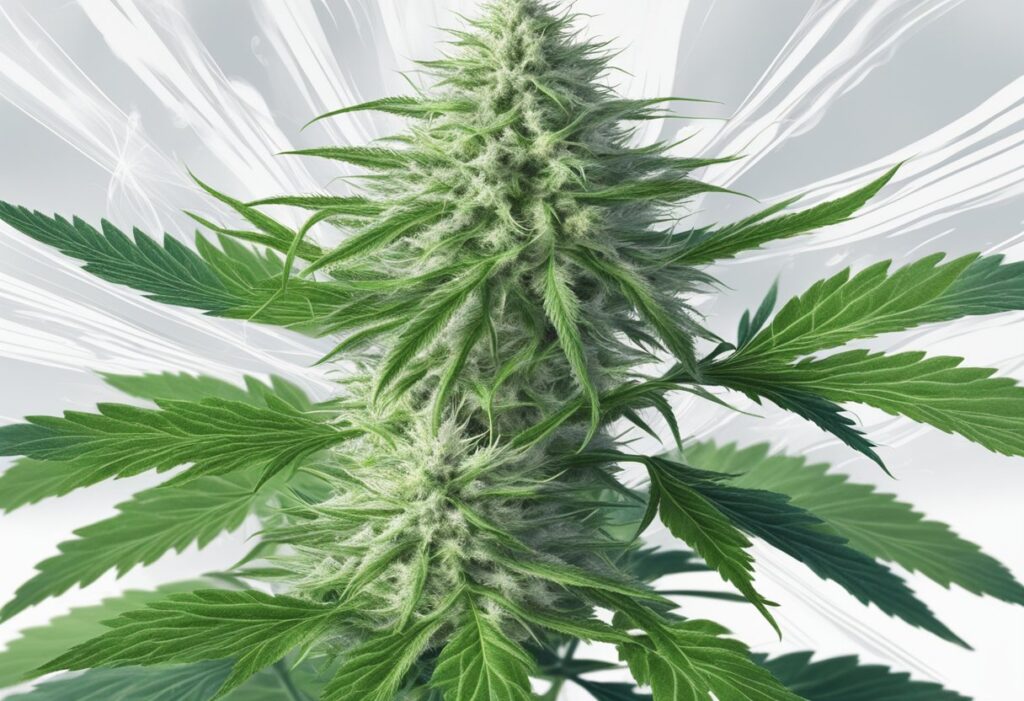
White Widow is a classic hybrid strain that strikes a balance between the relaxing qualities of an indica and the energizing aspects of a sativa. The origin of this strain can be traced back to the early 1990s in the Netherlands. It has built a reputation for powerful effects accompanied by a pungent aroma that has resonated with cannabis enthusiasts worldwide.
Genetics: White Widow emerged from a cross between a Brazilian sativa landrace and a South Indian indica, embodying the best traits of both parental strains. This genetic combination results in a robust plant with a rich lineage that provides a well-rounded experience.
THC Content and Potency: With a THC content that hovers around 21%, White Widow leans toward high potency. This level of THC contributes to the strain’s popularity among those who seek a strong and lasting effect.
Aroma and Flavor: The aroma profile of White Widow is complex and layered. When you take a closer look, you’ll detect notes underscored by its prominent terpenes:
These terpenes not only define its fragrance but also influence the strain’s flavor and potential effects.
Growth Characteristics: If you’re considering growing White Widow, you’ll be pleased to know that it’s suitable for intermediate growers. It prefers a warm, sunny climate and, when grown indoors, it can yield up to 18 ounces per square meter after an 8 to 9-week flowering time.
In the Canadian cannabis landscape, White Widow has secured its position as a strain synonymous with quality and heritage. Its reliable potency and unique terpene blend make it a valuable benchmark for comparing with other favorite Canadian strains. Whether you’re a connoisseur or new to the world of cannabis, White Widow is a strain that merits attention.

When you decide to grow White Widow, a classic strain favored in Canada, your approach to cultivation will significantly impact the final yield and quality. Whether you’re cultivating indoors or outside, understanding the specific needs of your strain is key.
For indoor cultivation, you’ll need to maintain careful control over environmental factors. White Widow flourishes under a light schedule of approximately 12/12 (hours of light/hours of darkness) during the flowering phase. To optimize growth, manage temperatures between 70-80°F (day) and slightly less at night. Humidity is another crucial element; strive to keep it around 40-50% to prevent mold on the dense buds. Pruning is also beneficial, as it can improve air circulation and light penetration to the lower parts of the plants.
If you’re growing outdoors, White Widow adapts well but thrives in a Mediterranean climate with ample sun exposure. In Canada, it’s essential to select disease-resistant strains to combat the variable weather. Start your cultivation early to take advantage of the growing season and employ robust plant training techniques to maximize exposure to sunlight and improve air flow within the canopy.
As harvest approaches, pay attention to the trichomes on the buds; a good indicator of maturity is when most trichomes go from clear to milky white. Remember that White Widow’s flowering time lasts about 60-70 days.
For optimal yield and flavor, consider flushing the plants—ceasing to provide nutrients—two weeks before harvest. This process can help get rid of residual nutrients and improve the final taste of the flowers.
Remember that these are general guidelines – your individual experience may vary depending on environmental conditions and the specific genetics of your White Widow strain.

When considering White Widow in comparison to other popular Canadian strains, you’ll notice that its effects and medical uses are distinctive for their balance between energy and relaxation. Let’s dive into how this strain stacks up against others in terms of its impact and therapeutic value.
White Widow is lauded for instigating a cerebral high that harmonizes euphoria with sharp energy, making you feel uplifted and creative. This is quite different from strains that may induce couch-lock—a state where you feel too relaxed to move. Instead, White Widow keeps you energized enough for daytime use, while still being capable of tackling issues like stress and anxiety.
| Strain | Effects | Best Used for |
|---|---|---|
| White Widow | Euphoric, energetic, focus | Daytime, creativity |
| Strain A* | Relaxing, appetite | Evening, relaxation |
| Strain B* | Uplifting, energizing | Socializing, daytime |
*Strain names are placeholders for other Canadian favorites.
Your experience with White Widow could include its notable analgesic properties, offering relief from chronic pain. It’s also reported to help with migraine relief and may ease muscle spasms. Given these benefits, it’s clear why this strain has become a choice for medical cannabis patients.
When discussing stress relief, White Widow may come ahead of other strains by providing a calming effect without sacrificing your alertness. Furthermore, if you’re wrestling with depression, the euphoric effects might serve as a mood enhancer. However, moderation is key, as the high THC content could be overwhelming for new users.
Remember, everyone’s body chemistry is different, and while White Widow has potential, the right choice for insomnia or appetite issues may be another strain with more relaxing qualities. Always consider your needs and consult with a healthcare provider regarding your use of medical cannabis.
White Widow typically delivers a balance of energizing and relaxing effects due to its hybrid nature. This distinguishes it from strains like pure indicas, which are more relaxing, or pure sativas, which are more uplifting.
White Widow’s THC levels can vary but tend to average in the low twenties percentile. This places it at a similar potency level to other top-tier Canadian cannabis strains known for their strong effects.
White Widow stands out due to its unique genetic makeup—a cross between a Brazilian sativa landrace and a South Indian indica. This mix gives it a distinct profile of both effects and flavors that is not commonly found in strains native to Canada.
Canadian strains that share a similar flavor profile to White Widow often have a deep, earthy scent with hints of woodiness, such as strains with Haze or Kush genetics.
Its well-rounded effects, which include mood improvement, creativity, and social comfort, make White Widow a favorite among Canadian cannabis users, especially those looking for a balance between relaxation and cerebral stimulation.


WE ARE EVERY GROWERS ONE STOP SHOP TO ACQUIRE PREMIUM CANNABIS SEEDS FOR SALE IN THE USA, CANADA AND AUSTRALIA
Farmers Lab Seeds 2024,
All Right Reserved
Seeds are sold as novelty items, souvenirs, and collectibles. They contain 0% THC. We encourage our customers to check the legislation in their Country, State, Province, and Municipality prior to purchasing items from our store. We do not provide growing information.
All seeds are sold as hemp, and lab tested under 0.3% THC. This product is not for use by or sale to persons under the age of 21. This product should be used only as directed on the label. It should not be used if you are pregnant or nursing. Consult with a physician before use if you have a serious medical condition or use prescription medications. A Doctor’s advice should be sought before using this and any supplemental dietary product. All trademarks and copyrights are property of their respective owners and are not affiliated with nor do they endorse this product.
These statements have not been evaluated by the FDA. This product is not intended to diagnose, treat, cure or prevent any disease. Individual weight loss results will vary. By using this site, you agree to follow the Privacy Policy and all Terms & Conditions printed on this site. Void Where Prohibited by Law.